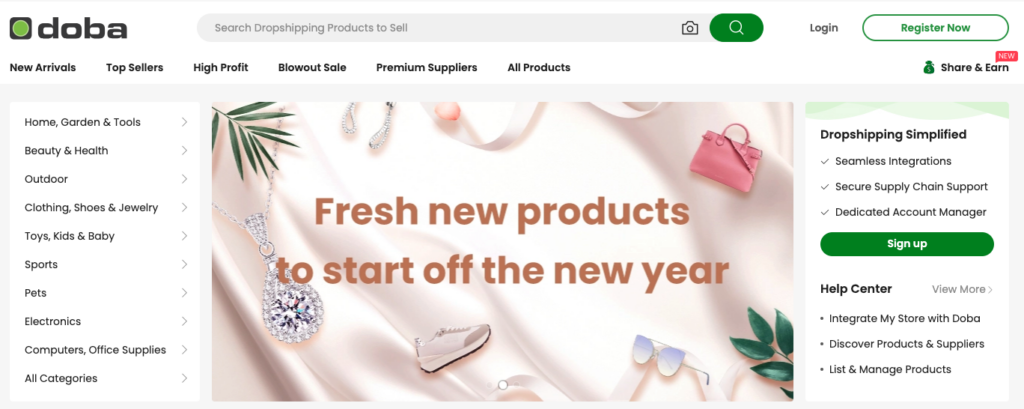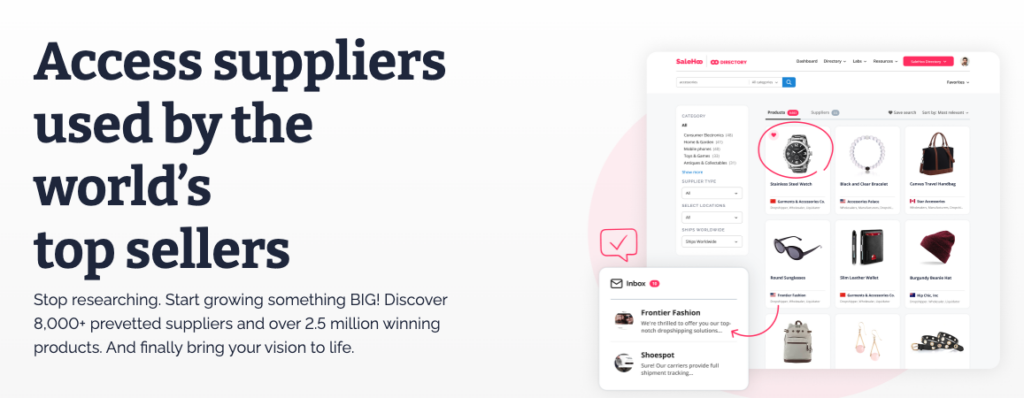
How to Start Dropshipping With WordPress
There’s no doubt that eCommerce opportunities have changed the business landscape. In fact, the number of internet users who make online purchases is set to surpass 65% by 2021. It follows that efficiently getting your products to all those customers can be vital to your success.
Fortunately, as the eCommerce marketplace evolves, so do your production and shipping options. Dropshipping is one excellent way to handle both of those tasks. It also enables you to avoid certain production challenges and streamline your workflow.
In this article, we’ll take a look at what dropshipping is and how it works. We’ll also discuss how you can use WordPress to set this feature up. If you’re ready to get started, we’ll dive right in!
What is dropshipping?
Dropshipping involves outsourcing the production and shipping of a product directly to a supplier. This means you won’t have to create, store, and ship your product. Instead, you’ll simply offer the product for sale, and work directly with a supplier to coordinate fulfillment.
The dropshipping business model is straightforward and relatively risk-free. First, you create a dropshipping website that sells specific products, then advertise to your target market. Next, when a customer completes an order, you’ll pass their information to your supplier, who will package and ship their product. Then all that’s left is for you to do is contact the customer with a confirmation and a timeline.
There are several pros and cons to this approach. Let’s take a look at the benefits first.
Benefits of dropshipping with WordPress
Dropshipping is an excellent way to cut down on overhead costs. For example, you’ll be able to reduce or entirely eliminate the cost of storage and assembly space for your product.
Additionally, even though dropshipping adds a layer to your process, it’s still a pretty simple business model. You’ll simply have to maintain contact with the supplier you contract your dropshipping to in order to make sure your customers are satisfied with the service. You get the benefit of working with an experienced shipping professional to move your products instead of being forced to figure out shipping costs and logistics on your own.
Drawbacks to dropshipping with WordPress
While there are many benefits to outsourcing this aspect of your eCommerce business, there are also downsides to be aware of. Consider for example the fact that you’ll have to spend quite a bit of time communicating with the provider you choose. Of course, this should be less of a problem if you’ve picked a reliable company to work with.
However, you might also run into problems with inventory. At times, providers may encounter supply chain issues that you don’t become aware of until a customer does not receive their order. This could also result from failed delivery methods.
In order to minimize these risks, you’ll want to put in some research before deciding who to trust your products with. We’ll introduce some dropshipping supplier services later in this article.
Why use WordPress for dropshipping?
It’s no secret that we really like WordPress here at WP Engine. It’s an excellent platform for a wide variety of purposes, including this one. When it comes to dropshipping, WordPress’ open-source core makes it easy for developers to create plugins that can help facilitate the process.
Consequently, WordPress can provide everything you need to integrate a dropshipping option into your existing eCommerce website (or a new one). Plus, the process is simpler than you might expect.
Dropshipping with WooCommerce
If you’re using WordPress, one way you can connect your customer-facing shopping experience to your suppliers is through WooCommerce Dropshipping. The WooCommerce plugin is the most popular eCommerce option for WordPress users. That’s why we’ll use it to demonstrate how to set up dropshipping for your eCommerce store on WordPress.
Step 1: Set up a WordPress website and install WooCommerce
To get started, you’ll need to have a WordPress website installed on your web host. Once you’ve done that, you’ll want to install and activate the WooCommerce plugin as well.
Once you’ve installed and activated the plugin, you can configure WooCommerce for your WooCommerce dropshipping store. You can use the provided setup wizard as a quick-and-easy way to get all the basic information in place.
After that’s taken care of, you’ll be ready to secure your WordPress website and protect your customer transactions. Of course, keep in mind that you can use an existing WooCommerce store if you already have one set up.
Step 2: Acquire an SSL certificate
One recommended best practice when setting up an eCommerce site is to ensure that customer transactions will be secure. In fact, this step is so important that Google requires it. To make sure your site is locked up tight, you’ll want to pick up a Secure Sockets Layer (SSL) certificate.
You can obtain one from a Certificate Agent (CA), or check with your web host to see if it provides an in-house option. For example, here at WP Engine we offer free and automated SSL certificates with all of our plans. You can find SSL-related information in your User Portal.
There, you’ll be able to add a Let’s Encrypt SSL certificate to your domain. Depending on the type of eCommerce business you are setting up, however, you might want to look into more robust types of certificates. Even if you purchase a certificate elsewhere, you can still add it through the SSL menu.
Step 3: Choose a theme and design your site
Now that you’ve secured your site and configured the base WooCommerce plugin, you’ll want to design your online store. There are countless eCommerce themes available for WordPress, with many free options in the WordPress Theme Directory.
However, if you are looking for a premium eCommerce WordPress theme, we recommend checking out some of the StudioPress themes that come with all of our web hosting plans.
Monochrome Pro and Infinity Pro are just two of many themes backed by the Genesis Framework. This means they’re ready for eCommerce, built using clean code, and packed with plenty of useful features.
Step 4: Add products to your store
Before setting up your dropshipping system, you’ll need to add some products to your store. You can do this by navigating to Products > Add New in your dashboard.
After you fill in all the necessary information and publish your product, it will be available for other WooCommerce functions. This is important in the next step, where you’ll connect your dropshipping information to your new products.
Step 5: Purchase and install the WooCommerce Dropshipping add-on
In order to execute a dropshipping strategy with WooCommerce, you’ll need to purchase the WooCommerce Dropshipping add-on. This will cost $49 per year for a single-site license.
Once you purchase the add-on, you can download it from your WooCommerce account and upload it to your plugin directory. Then you’ll need to activate the WordPress plugin, and it will be ready to go.
Step 6: Configure your dropshipping settings
Finally, you’re ready to add your suppliers and their information to your dropshipping database. To do this, go to WooCommerce > Products > Suppliers, and enter the relevant details about the dropshipping services you’re using.
Back under the WooCommerce > Products menu, you can edit each product that will be using a dropshipping supplier. You’ll see a drop-down menu on the right side of your edit screen, where you can select from the suppliers you’ve added to your site. Then the product will be connected to the supplier you chose.
You’ll want to fully investigate the WooCommerce Dropshipping plugin documentation, in order to understand how to manage your inventory and customize your packing slips. If you run into any problems or have any questions, don’t forget that WooCommerce also offers top-notch support.
Dropshipping services and plugins
While WooCommerce has many excellent features, you’ll still need to determine who your dropshipping suppliers are going to be. To help get you started, we’ll highlight several services that might be useful as you set up your dropshipping business.

1. Doba
Doba is an online catalog of product suppliers and manufacturers. This service enables you to find and connect with suppliers, as well as create and manage lists of products. Additionally, you can export your lists for use on your eCommerce platform.
Doba offers a 30-day free trial, with a “startup” plan that starts at $25 per month. While there’s no dedicated plugin for Doba, there are plugins that can assist you with uploading the data exports it will provide for you.

2. AliExpress
AliExpress is one of the largest global wholesale marketplaces available. One benefit of using this service is that there are several plugins that can help connect your products to your eCommerce website. There’s even an official WordPress plugin you can try out, which costs $89 for one license.
You can get started with AliExpress by putting a catalog together immediately after setting up your account. Once customers start purchasing your products, you’ll pay AliExpress the wholesale price and they’ll take care of the rest.

3. SaleHoo
Last but not least, SaleHoo is another wholesale marketplace. There, you’ll find over 8,000 wholesale and dropship suppliers. One of the benefits of this option is that SaleHoo reviews and vets all of the suppliers in its marketplace.
You can get started with SaleHoo for $67 per year. That comes with around-the-clock support, access to a members-only forum, and personal email support. This is one of the more hands-on services when it comes to supplier marketplaces.
Promoting your dropshipping business
Many entrepreneurs who enter the dropshipping business forget the most important part of the process: promotion. Your dropshipping store doesn’t have the name recognition or a loyal following, so you need to generate leads through marketing. Here are effective ways to approach promotion.
Social media advertising
With billions of people on social media, you can reach enormous audiences with ease. The only catch is that you’ll have to pay for it. Thankfully, if you strategize well, you’ll make your money back in no time.
Facebook and Instagram are the easiest for beginners to advertise on, and the user base is massive. All you have to do is create a Page or account for your online store, then invest a few hundred dollars to boost a post.
Best of all, you can advertise to groups of people based on their age, location, interests, education level—the list is never-ending. Target (and retarget) demographics that match your product niche, and you’ll be selling in no time.
Influencer marketing
By associating your product with influencers on YouTube, TikTok, or Instagram, you can place your product in front of a captive audience. Influencer marketing is especially cost-effective among younger generations, but all demographics are reachable.
Many beginner drop shippers make the mistake of approaching world-famous influencers. Big names will charge a fortune for advertising (if they respond at all). Instead, try contacting lesser-known creators with tens of thousands of followers.
Optimizing your dropshipping business
A successful drop shipper knows the work is never finished. To maintain a steady stream of revenue, you’ll need to continue optimizing your business. That means spending time looking at analytics on Google, WordPress, social media, and any plugins you’re using. You need to know what’s working—and what isn’t.
Optimizing may include:
- Changing the targets of your ads
- Modifying pricing to be more competitive
- Reorganizing your dropshipping website to be more intuitive
- Installing an “Abandoned Cart” plugin
Check on your business regularly, and always be ready to adapt.
Stay current with WP Engine
Starting up a dropshipping operation can solve many issues that new business owners face. This includes the need to purchase and eCommerce store inventory. Dropshipping can enable you to offer a wider variety of products, without the need to keep inventory on hand.
Getting your eCommerce store up and running can require an enhanced set of developer resources. Additionally, you’ll want to make sure site maintenance and security are rock solid with hosting built specifically for WordPress sites. Check out our managed hosting for WordPress plans, and secure your eCommerce storefront today!


